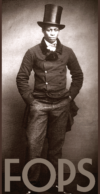
Given that James Bond is the epitome of cool, it could be disappointing to learn that his real-life inspiration was a dude called Wilfred “Biffy” Dunderdale.
But, as a new book about the British MI6 spy service reveals, we’re pleased to report that ol’ Biffy was a pretty interesting character himself. Here are some of the cooler facts we know about Dunderdale … Biffy Dunderdale.
He Lived a Thrilling James Bond-Lifestyle Himself
Years into his career, Dunderdale was married to a gorgeous blond, American woman named June Morse, who told anyone who asked that her husband worked in “passport control” — a common euphemism for military intelligence. The two lived in a luxury flat near the Eiffel Tower while stationed in Paris.
Dunderdale delighted in introducing his friends to the owners of the nightclubs he frequented and insisting that his chaps be given free champagne. The book’s author, Keith Jeffrey, told the British Telegraph that “when head of the Secret Intelligence Service Paris station in the 1930s, he had a penchant for pretty women and fast cars.”
It’s been said that being married to a beautiful American in Paris provided a cover asset — and this is probably partially why Ian Fleming, in creating the character of “007,” gave him all of those Bond Girls. Well, that, and to give future Bond fans the chance to see Olga Kurylenko in that dress.
Keep reading to learn more about the ways Biffy stuck it to the Nazis and looked good doing it.
![JamesBond[1]](https://www.fopsobserver.com/wp-content/uploads/2010/09/JamesBond1.jpg)
That Scene in “Goldfinger” Where Bond Removes His Wet Suit, Revealing a Tuxedo? That Actually Happened
It didn’t happen to Dunderdale himself, though he’s widely described as a “raconteur” and was reportedly thrilled to see his experiences appear in Fleming’s work. But Dunderdale did relay the story of a Dutch spy named Pieter Tazelaar to Fleming. Not only did Tazelaar emerge from his rubber suit in fine evening wear before entering a waterfront casino, he even splashed a few drops of Hennessey onto his tie in order to make sure that everybody knew he’d been partying.
He Was Born in Odessa and Spoke Fluent Russian
In fact, one of Dunderdale’s favorite stories of his early years involved working as a translator for a Tsarist general. In a scene that we’re stunned never made it into a Bond flick, he was tasked with translating between the Russian general and his British mistress, from outside of a train’s sleeping compartment. While helping another dude hook up may not sound particularly Bond-like, consider this: Biffy was still a teenager at the time.
He Was a Pretty Good Boxer
The British have weird names for things, and apparently you don’t get called something like “Biffy” without some serious inside-the-ring, boxing prowess. (Just ask Muhammad “Biffy” Ali.) During World War I, Dunderdale served in the British Navy, and he was a good enough fighter that he bore the nickname, which proclaims skills in the sweet science, for the rest of his days.
He Didn’t Have a “License to Kill” and His Codename Wasn’t 007, But He Did Place Almost 60 Agents in France During WWII
Apparently no one had a license to kill, though MI6 did have a list of potential assassination targets that they opted against acting on. They realized that the risks of German retaliation outweighed the reward of a few more dead Nazis. Dunderdale instead managed to help 57 spies into France to fight the good fight. Fleming similarly made up 007 as a codename; British Intelligence agents aren’t given numbers, but names.
We’re not sure what Dunderdale’s codename was, but we’re willing to bet it sounded cooler than “Biffy”
Via: Asylum
